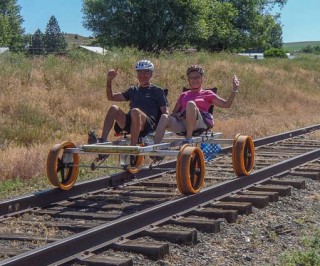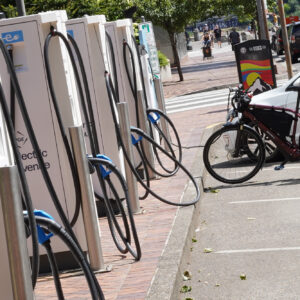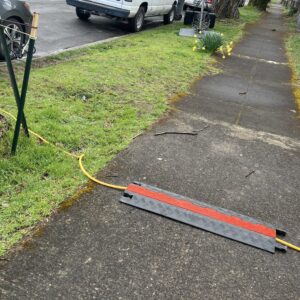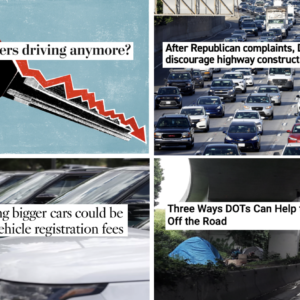
(Photo: Road Less Traveled)
This week’s news roundup is sponsored by Western Bikeworks, who reminds you to join them for their shop ride this on Sunday (8/10) followed by a Team in Training BBQ fundraiser that afternoon.
Here are the great bike links from around the world that caught our eyes this week:
The “rail rider”: This looks like a fun way to get around rural Oregon.
Wireless e-bikes: These concept bikes imagine a future “where inductive bicycle lanes could be used to wirelessly charge electric bikes and other devices on the go.”
The bike collapse: What killed the 1890s bike boom? A fascinating new essay argues that poor people started biking, which made it uncool.
How to teach: Elly Blue’s account (with tips) of how to teach someone to ride a bike is heartwarming.
Domestic bike-making: Betting that labor costs in China will keep rising, Walmart is subsidizing a new bike factory in South Carolina. Workers make 500,000 bikes a year and up to $12 an hour.
Licensing rights: Oregon Safe Roads is a new campaign to let Oregon residents without green cards become licensed drivers, “reducing the number of uninsured and untested drivers on the road.”
Car freedom therapy: A therapy created to treat addiction is being used to reduce car reliance.”
Bikesnob strikes: He writes of Oregon Manifest‘s design contest: “Just when you think nobody can improve the bicycle, someone proves you right.”
Road-rage mayor? A Missouri man claims that a suburban St. Louis mayor drove into his bike on purpose. (The mayor tells things differently.)
Speed conflict: A 55-year-old Florida Critical Mass ride leader was dragged off his bicycle after he complained to a police sergeant that the 3 mph pace she’d ordered was too slow.
Brazil’s bikes: Critical Mass is wrapped up in the recent bike boom of Porto Alegre, Brazil.
Advertisement
Protection trend: Cincinnati got its first protected bike lanes this week.
Legalizing protection: After years of pretending they don’t exist, California’s legislature might finally decide to declare that protected bike lanes are a thing.
Streetcar sketpicism If “mixed-traffic streetcars don’t particularly offer useful transit, nor are they necessarily the only/best/cheapest placemaking tool, then I have to wonder if 30 years from now we’ll look back on them as yet another expensive urban renewal fad,” writes one fan of faster-moving mass transit.
More streetcar skepticism: Vox’s Matt Yglesias opens a full broadside against streetcars. “Securing funding for a boondoggle often seems more politically realistic than the harder problem of tackling the entrenched interests of (heavily subsidized) frequent car drivers,” he writes.
Theory of change: “Much like feminism, bike advocacy can be looked at in waves,” says the League of American Bicyclists’ new Women Bike Manager, Liz Jones, about the debt transportation advocates owe to athlete-driven advocacy.
Sidewalk police: Gothamist’s quick take on police officers who bike on sidewalks is good for a smile.
Normalizing violence: NPR’s ombudsman says this spot shouldn’t have presented as reasonable a woman’s confession that she deliberately tries to frighten bikers by driving next to them.
20 is plenty: London’s banking district got a new municipal speed limit last month. Officials say it’ll cut fatalities 7 percent and add 25 seconds to the average 1.6-mile car trip.
Selling bike share: The latest report, last Tuesday, puts REQX Ventures in “advanced negotiations” to buy a majority stake in Alta Bicycle Share.
Bike share and helmet laws: Seattle Bike Blog looks at the grim particulars of running a bike share system in a city where bike helmets are mandatory even for adults. (Alta’s Seattle system will launch next month.)
The latest Streetfilm, your video of the week: takes a short look at Buenos Aires, second city of South America and the site of rapid transportation change in the last few years:
If you come across a noteworthy bicycle story, send it in via email, Tweet @bikeportland, or whatever else and we’ll consider adding it to next Monday’s roundup.






Thanks for reading.
BikePortland has served this community with independent community journalism since 2005. We rely on subscriptions from readers like you to survive. Your financial support is vital in keeping this valuable resource alive and well.
Please subscribe today to strengthen and expand our work.
that mayor is toast
@NPR’s ombudsman Aug 1
@BikePortland Sorry for delay. Listened to the piece. Reporter was correct to give balance to other side (who oppose bike paths)… (1/2)
@NPR’s ombudsman Aug 1
@BikePortland However, should have added something after “threat” quote that it is incredibly dangerous. Will send note to reporter (2/2)
emphasis mine
<sarcasm>
It IS very important to present both sides as equal … especially when one of them is potentially homicidal with the maturity and forethought of an angry destructive toddler.
</sarcasm>
“Both sider-isms” are only valid journalistically when both of those sides are not basing their philosophy upon the violation and subjugation of the other side.
If you don’t like the other side: FINE. That’s ok. It doesn’t mean that you get to attack them or give you carte blanch to violate their right to live.
James Fallows of The Atlantic has written often in the past couple years against what he calls false equivalence: “The essence of the false-equivalence mindset is the reflexive assumption that ‘reality’ is halfway between whatever two contending sides assert.”
Just because there are two sides to a story doesn’t mean that both sides have equal claims to the truth. Reporters aren’t doing their job when mindlessly pass along the opinions of both sides without doing some reporting about the verity (or, here, the legality and morality) of their claims.
Only two sides? More often than not there are actually seven.
“I don’t think there are two equal sides to every story.” -Edward R. Murrow
What she said:
“…BURKE: It’s very frustrating to the point where I want to just run them off the road. And I’ve actually kind of done one of those drive-really-close-to-them kind of things just to scare them to try to intimidate them to kind of get out of my way. …” npr story
Was Burke’s admissions about what her frustrations had her doing once, when driving with people on bikes on the road, “…presented as reasonable…” by the npr story? Some people think so. NPR allowing Burke’s remark to be a part of the story, without some kind of counterpoint, seems to have been more of an oversight, rather than than a suggestion that the action was reasonable.
For Jackie Burke’s part, in reading the text of the story, what she said, sounded like poor judgment in making an off handed remark. In only reading the text of what apparently was a radio story, I can’t tell for certain, whether Burke actually may have been riding in the LA Biketrain that day, or if her remark was as a driver, for one of those spot interviews news people like to grab along the way in making stories. Maybe someone reading here, is certain.
You are ridiculous.
I actually had the same sort of confused lacking-contextual-clues sort of thoughts.
SO I LISTENED TO THE AUDIO IN FULL.
The person who expressed impatient outrage a bicycle riders existing was not related in any way to the rest of the story. Tye NPR story writer in this case simply plucked a random driver from the font of carhead rage and gave her a podium upon which to legitimize irrational driver rage.
It was as if this story was written by a computer algorithm: a check box said “include opposing view” so it was included in the absence of any logic, reason or sanity.
“I actually had the same sort of confused lacking-contextual-clues sort of thoughts.
SO I LISTENED TO THE AUDIO IN FULL.
The person who expressed impatient outrage a bicycle riders existing was not related in any way to the rest of the story. …” q`Tzal
q`Tzal…thanks for listening to the audio and offering your impression of whether or not Burke was associated with the bike train that day. I could be wrong, but it seems the radio reporter must have at least asked Burke about the bike train, even if Burke wasn’t riding with it. She seemed to at least know what the bike train was. That’s suggested in her earlier remark, just before the before the excerpt I posted.
I’d still like to know more about how Burke came to make the remarks to this story she did. There’s a significant difference if she made them simply as someone driving, reflecting on her frustration in dealing with bikes on the road, or if she made them as someone newly trying out riding with a bike train, and contrasting her experience there with when she has driven.
The transcript looked to have been edited by a drunk 5 year old; the layout of the monolog of the story not much better.
The first time I just listened to the last half of the audio. Aghast I listened to the whole thing at once, then once further to attempt intentionally misinterpret bits to see how different the narrative would sound from another angle.
We can ASSUME that the impatient driver was nearby, saw the bike and was reacting to it on the record. Unfortunately there is no information supplied in the published broadcast that lets the audience know when and when this driver was interviewed.
For all we know it could have been a generic “driver angry at cyclists” clip recorded days, months or years earlier.
What we do know is the NPR editor chose to include a bit of pointless irrational rage just because.
“…We can ASSUME that the impatient driver was nearby, saw the bike and was reacting to it on the record. Unfortunately there is no information supplied in the published broadcast that lets the audience know when and when this driver was interviewed. …” q`Tzal
I thought about Burke’s comments in the broadcast story, possibly coming about in such a way. Again, I haven’t heard the audio version. Verbal intonations, emotions and whatnot, can be hard pressed to come across well in a transcription.
NPR’s staff seems to have dropped the ball on this one. I did read the npr tweets by way of the link provided in this bikeportland story. The words about following up with the reporter to review and have changes made, could have been better.
People ought to be able to expect NPR to consistently edit its stories for clarity and quality, before they air them. When they make a mistake, which they seem to have here, their listeners should be able to expect a clear explanation of what actually was intended to be implied by remarks made in the broadcast.
I work on NW Lovejoy and am always surprised/pleased to see how packed the streetcar is. It’s also pretty quick moving.
Blue’s braking advice is terrible. My rear brake is primarily an emergency backup for the front. We are taller, heavier, and stronger adults. It takes an indelicate hand and seriously grabby brakes to go over the bars than when we were kids.
they are also useful when you are afraid of losing traction but otherwise agree.
I think it’s great advice. To a new biker it can be quite a surprise what happens when you squeeze the front brake hard on a fast descent… going over the handlebars like that scared my daughter off of using the brakes for weeks. She’s only just now stopped dragging her feet to stop. (“Look dad I’m using the pedal brake!”)
What is a new rider doing on a fast decent?
If you shift your weight, its nearly impossible to go over. Ideally, you’d be able to shift your weight before doing a fast descent…
Doh! reply below.
Using the front brakes first, person riding may not go over the bars in a hard brake situation, but the front wheel can lose traction and want to slip away from the rider’s center of gravity. Such as when the rider finds they need to turn the bike after the front brake has been applied. Sometimes, front brakes first are fine, but generally, rear first, or both together are better.
Nice write up by Blue. Congrats on sucessfully helping someone to learn to ride for the first time.
Vancouver BC’s Dead Baby Bike Club made a railroad tallbike!
You mean like the indelicate and unskilled hands of an adult who has never operated a vehicle with anything other than hydraulically assisted power brakes?
Or perhaps an adult who has more disposable income than the hypothetical child and can afford a quality finely tuned bike from a professional bicycle shop but said adult is too embarrassed to admit they’ve never ridden a bicycle?
The front brakes are definitely the go to for routine stopping force but in the same way that you don’t train your teenaged son to drive stick in a Ferrari it is also well advised to train bike riding at slower speeds with a brake that won’t dump a novice.
PS: after 14 years of road riding experience with all sorts of equipment, traffic and weather I finally got around to getting my new wheels trued perfectly at the same time as getting new brake pads and simultaneously tweaking the pads to be as close as possible to the rims without friction.
Can you guess where this is going?
Unluckily when it did I was in front of a group of pedestrians laughing at the near full somersault my bike did.
Luckily I was able to do that gymnastic pommel horse vault over the handlebars and land coolly on my feet as if “I meant to do that”
“…fun way to get around central (?) Oregon.” I suppose, if it was taken there.
Ha! BikeSnob’s takedown of Oregon Manifest is just too good.
But it’s becoming too routine.
Where’s the hurtful barbs that point out Portland’s delusion that we are the bike capital of anything?
Save us from ourselves BikeSnob! Insult us back to the glory we once were!
I’m just kidding, right? I think I am…
It’s too easy to just sit back and say “Nothing new should ever be tried. Harrumph.” and take shots at those trying. I didn’t find BikeSnob very enlightening though, in this case. The admission that it only looked at one bike did kind of shed some light on where they’re coming from.
New can be great, but new at the expense of long-term usability serves nothing. Retractable widgets made of proprietary hardware? Integrated locks I can cut with a steak knife? What a brilliant plan.
If the bike has parts that can’t be replaced if they break or wear out in five years, then it is virtually useless as a “utility bike”. End of story.
I wrote about the OM bikes about the same time as BSNYC and it’s interesting to read his article since it shared many of the same opinions. (I’m not a regular reader of his.) It makes me wonder how many other people shared the same. I didn’t voice all of mine as aggro or negatively and tried to critique them based on market potential. (Since they will be cranked out as cheaply as they can by Fuji.) And the theme was “urban utility” – so regardless of the inventiveness of the bike; which one was able to fit the theme.
I’m definitely against the Oregon Safe Roads (Yes on 88) campaign. Foreign nationals can already legally drive in Oregon with their International Drivers Permit. This will also allow them to purchase insurance locally as well (though most will have coverage from their insurance company in their home country).
To echo Charlie above – Joseph and Enterprise are in Northeast, not Central Oregon. I lived in that community for 20 years and the rail rider is new but I may just give it a try on my next visit.
In many countries, there would have been a riot instigated by the Ft Lauderdale Police behavior. Not in ‘Murica, I guess. WTF.
In Soviet Florida, COPS riot YOU!
Kids learn to ride fixed on tricycles.
Why do we make them learn to finesse the cranks through the vertical dead zone that a freewheel requires at the same time they are trying to learn how to balance?
Look at the little guys. They always get stuck with the cranks vertical when learning!
Cool, wireless bike charging, cancer all around!
Junk science failure, sorry please play again!
Not a snarky question at all, but why do those people on the railroad recumbents need helmets? Is there even a remote chance they’ll fall out and land on their head?
Styrofoam shell of the helmet helps keep their heads cool, just like those foam coolers help keep your beer cool. Also helps keep the sun out your eyes.
Styrofoam shell of the helmet helps keep their heads cool, just like those foam coolers help keep your beer cool
wsbob,
excuse me, but that may be the dumbest thing you’ve written here. Styrofoam is an insulator. If the beer is cold and in a cooler, well, sure. But neither my head nor yours is a cold beer. Putting my/your head in a piece of styrofoam is going to keep the hot in.
The foam insulates from greater heat originating outside the helmet. The vents in helmets enhance the helmet cooling capability by enabling a wind chill effect.
There are herds of antelope in Eastern Oregon…perhaps that’s the danger.
No, I find my helmet is effective at keeping my head cool. Better than a hat – keeps the sun off, has these giant ventilation slits that allow air through.
That (helmet = ventilator/visor) makes infinitely more sense that wsbob’s beer cooler analogy.
It’s so when someone in a car comes blasting across the prairie and takes the railbike out broadside, corporate news can’t blame it on the fact that they didn’t have the helmets.